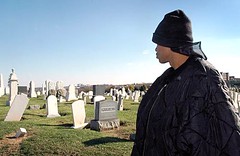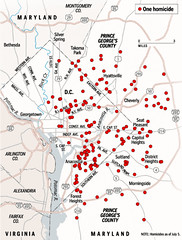Murder: muddled writing and hand wringing don't address the real issues
 Antonio Henry, 17, a high school senior, thinks often of his best friend, who was shot and killed. Henry and other youths went to Baltimore Cemetery as part of a program to teach them that if they stay in the streets, it could happen to them. (Sun photo by Chiaki Kawajiri)Nov 17, 2005.
Antonio Henry, 17, a high school senior, thinks often of his best friend, who was shot and killed. Henry and other youths went to Baltimore Cemetery as part of a program to teach them that if they stay in the streets, it could happen to them. (Sun photo by Chiaki Kawajiri)Nov 17, 2005.Sometimes I sound callous because I think it's important to distinguish between murder and other crimes. Most murders happen where the perpetrator knows the victim. The kind of murder that happened in Georgetown a couple nights ago is unusual. See "Slaying Suspects Linked to Holdups."
I do think it's especially interesting that if the people arrested for the Georgetown crime are tied to previous assaults and robberies such as those on the National Mall in June, that it's clear that as they remained uncaught, their exercise of violence escalated, culminating in murder. (This general principle holds true for criminal behavior. What people do escalates, as they remain unpunished. It's a basic aspect of the "Broken Windows" policing philosophy.)
So today's Post story "In Renewed Area, Crime Remains" subtitled, "Residents Say Revitalization Incomplete in D.C. Neighborhood Where Activist Died," I would call but another "Department of Duh" newspaper story.
First, the headline is inaccurate. I would say the neighborhood is "renewing;" it's not "renewed," whatever renewed means.
The commercial areas are bleak, New York Avenue is a cesspool of traffic, the neighborhood is a mix of lower-income housing, long-time residents, and new higher-income residents, the main corridors, 7th and 9th Streets, are empty and especially at night, feel forlorn and somewhat menacing, and nearby K Street, long a center of transvestite prostitution (I think it still is, I no longer work in Dupont Circle and come that way home from work late at night), is still "interesting."
It's a potent mix, always ready to explode.
Second, unlike in Georgetown, the person murdered is an old-time resident, not a new resident.
And the antecedents of crime and violent behavior in DC neighborhoods tend to be the old residents not the new residents.
There was a murder in the eastern part of the H Street neighborhood last week (note that Stop, Blog and Roll has been logging the murders occuring in the Northeast quadrant, and it certainly appears to be rising and a cause for concern--the question is why is this happening and how can it be addressed and interdicted) and someone wrote on an e-list asking if suspects and motives are known. This is what I wrote:
The MPD puts out a press release for every murder, here's that one... As far as motives, etc., I'm sure it's similar to most of the murders in DC, where about 70% or more of the time, the perpetrator knows the victim.
-- correlates of violent behavior
slide 1
slide 2
-- seven kinds of aggression
slide
Or slog through Code of the Street and Streetwise by Anderson--which I have written about quite a bit, Murders in New York City by Monkkonen, and Violence : Reflections on a National Epidemic by Gilligan. For more on Elijah Anderson's work see these blog entries:
-- Richard's 2.5 Rules for City Living...
-- Where is the outrage?
-- I don't read the Post first thing in the morning...
-- Read the book, watch the movie
-- as well as this entry about Prince George's County, In a rising real estate tide, some communities get swamped.
Monkkonen, analyzing two centuries of data of murders in NYC, finds that most murders happen today for the same reasons. Murderers are most often men and murders are most often committed in the heat of passion, as a result of an argument. "Usually, the motives are the need to assert manliness, power or territory," he says. See the press release for more information on Murder in New York City.
So how does wringing hands over policing, or holding a candlelight vigil address the issue of why people are willing and eager to use violence and weapons to settle differences?
The kind of murders the police can impact are the type we saw in Georgetown. Had the perpetrators been caught earlier, this murder likely would not have happened. Still, that's maybe 20% of the total. To impact the rest requires more than handwringing, and more than just a throwaway article by the Washington Post.
Note that the New York Times did a big story in April, "New York Killers, and Those Killed, by Numbers," analyszing all the murders in NYC from 2003-2005. They found that "Between 2003 and 2005, 1,662 murders were committed in New York. Men and boys were responsible for 93 percent of the murders; their victims tended to be other men and boys; and in more than half the cases, the killer and victim knew each other." While the story is not online for free, the interactive map showing the location of all the murders, remains open access. This is the kind of story that I am waiting for the Post to publish...
 Caption: border between Prince George's County and the District is a high-crime area. The map shows where homicides have taken place this year in the two jursidictions inside the Capital Beltway. Graphic by Richard Furno, Nathaniel Vaughn Kelso and Tiffany Sakato, THE WASHINGTON POST. From "Living on Edge of Violence: District-Prince George's Border Is Region's Most Dangerous Area, 2005."
Caption: border between Prince George's County and the District is a high-crime area. The map shows where homicides have taken place this year in the two jursidictions inside the Capital Beltway. Graphic by Richard Furno, Nathaniel Vaughn Kelso and Tiffany Sakato, THE WASHINGTON POST. From "Living on Edge of Violence: District-Prince George's Border Is Region's Most Dangerous Area, 2005."Index Keywords: public-safety; quality-of-life-advocacy



0 Comments:
Post a Comment
<< Home